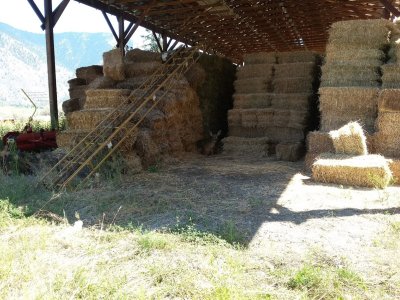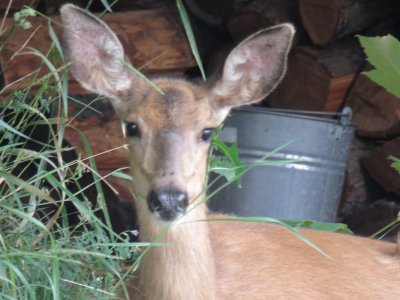You are using an out of date browser. It may not display this or other websites correctly.
You should upgrade or use an alternative browser.
You should upgrade or use an alternative browser.
Deer
- Thread starter Nesikep
- Start date

Help Support CattleToday:
Cool pic Nesi.
ALACOWMAN
Well-known member
All that food and shelter at her disposal..who would want to leave
Nesikep
Well-known member
ALACOWMAN said:All that food and shelter at her disposal..who would want to leave
exactly, nice shade, prime, fresh hay and green alfalfa just steps away.. Life is pretty good! I was surprised she didn't spook when I was driving in and out though
Dont' know if you can see it, but this is a little later, my mother was walking by and they were a few feet away from each other
https://photos.app.goo.gl/bgcyStN874fjiiAE9
ALACOWMAN
Well-known member
Can't see it ..but she invite friends to the party...
DCA farm
Well-known member
Smart deer couple months bet she won't be doing that. Or shed only do it once around here
76 Bar
Well-known member
Nesi needs to publish one of those glossy pictorial coffee table books. 8)
Nesikep
Well-known member
76 Bar said:Nesi needs to publish one of those glossy pictorial coffee table books. 8)
I'd need a camera that takes glossy pictures though.. cell phone cameras just don't cut it except for getting the idea of something
That's awesome! She's got it pretty good. We had a twin fawn get caught in an old cattle panel in the woods behind the house last year. Got it loose and mama & the twins hung out around the house until hunting season. The twins kept their distance but mama never ran from me and I would occasionally give her cattle cubes.


cowrancher75
Well-known member
- Joined
- Mar 8, 2019
- Messages
- 224
- Reaction score
- 1
i just mowed 2 babies today
Oooooh, I'm so sorry! It happens. Our brome & bermuda fields were cut today and there are a ton of buzzards circling. Fortunately this year they didn't nail a skunk.cowrancher75 said:i just mowed 2 babies today
Anyone who kills a fawn or finds one dead should check the mouth to see if it has an underbite (the lower incisors being anywhere forward of the dental pad rather than contacting the dental pad) or an overbite (short lower jaw). On male fawns check to see if they have a normal length, bilateral scrotum and a normal length penis sheath (on WTD newborn males, the penis sheath should be at least 1 1/8 inches long and on adult males 2 inches or more). If you find a fawn or an adult harvested deer with any of these birth defects, you should report it to your Game and Fish Department. Some states have a very high prevalence of underbite and male reproductive malformations and it would be good to find out what is causing these conditions. Quite a few human newborns have the same birth defects and heart defects are considered the number one birth defect in human newborns. Heart defects were the third most common birth defect on wild animals beginning in 1995. That was when the other birth defects mentioned above began on ruminant newborns, other wildlife newborns and human newborns.
greybeard
Well-known member
By the time I find them, they are either already tore up by coyotes or stink so bad I prefer not to get anywhere close to them.
So many deer here, they have become a huge nuisance. They cleaned up every one of my scuppernongs this year, about a week before they were ripe enough for me to harvest.
So many deer here, they have become a huge nuisance. They cleaned up every one of my scuppernongs this year, about a week before they were ripe enough for me to harvest.
wbvs58
Well-known member
Dam that climate change.Anyone who kills a fawn or finds one dead should check the mouth to see if it has an underbite (the lower incisors being anywhere forward of the dental pad rather than contacting the dental pad) or an overbite (short lower jaw). On male fawns check to see if they have a normal length, bilateral scrotum and a normal length penis sheath (on WTD newborn males, the penis sheath should be at least 1 1/8 inches long and on adult males 2 inches or more). If you find a fawn or an adult harvested deer with any of these birth defects, you should report it to your Game and Fish Department. Some states have a very high prevalence of underbite and male reproductive malformations and it would be good to find out what is causing these conditions. Quite a few human newborns have the same birth defects and heart defects are considered the number one birth defect in human newborns. Heart defects were the third most common birth defect on wild animals beginning in 1995. That was when the other birth defects mentioned above began on ruminant newborns, other wildlife newborns and human newborns.
Ken



